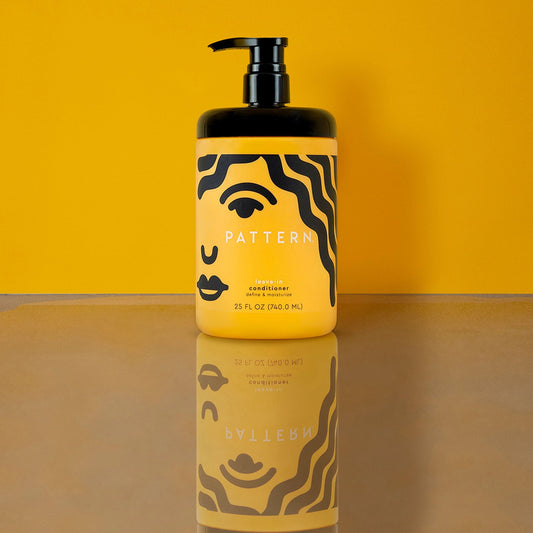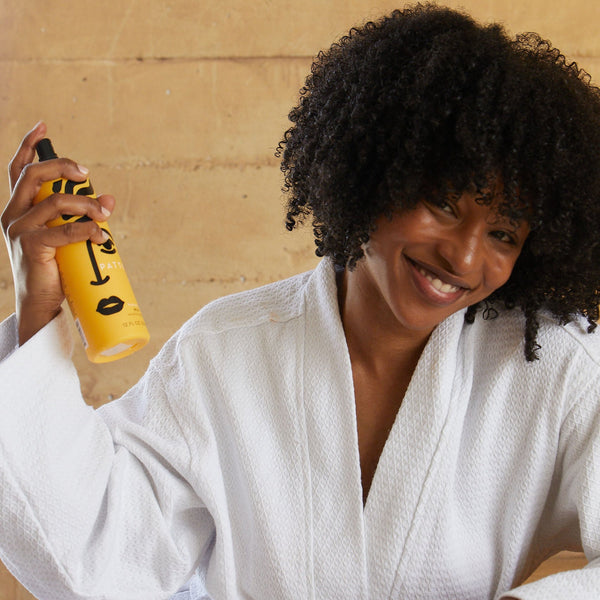If you have curly, coily or tight-textured hair, you might already know that your hair is pretty special. But keeping your curls joyful & uplifted also might mean you need a few equally special techniques—especially at night.
Yes, we’re here to talk about hair wrapping.
If you’re new to hair wrapping techniques, learning how to wrap your hair at night might not always seem straightforward. But finding the right wrapping method for your hair can help to keep away frizz, preserve your style & even help to lock in hydration.
Say hello to waking up with voluminous, defined curls. It’s time to start wrapping.
Step 1: Determine Which Wrapping Method is Right for You
Sometimes it might seem like your curls have a mind of their own—a creative, powerful, ferocious mind! But all that uniqueness also means some wrapping methods might work better than others.
The first step to learning how to wrap curly hair at night is to determine which wrap method will best suit your hair type, length & style. Which method you choose may also vary depending on when you wash your hair or change your style.
Let’s walk through a few different methods & how to know which one is best for you.
Bonnets
The main goal of a curly hair satin bonnet (sometimes also called a hair cap) is to prevent friction against your pillow & sheets while you sleep. Thanks to its friction-fighting abilities, a silk or satin bonnet can help you avoid frizz, protect your curls’ delicious definition & even prevent breakage.1
Bonnets are relatively easy to put on before bed & their fit tends to be relatively loose. Because they don’t compress your curls, they’re an excellent choice for those who want to avoid flattening their curly hair.
Bonnets can also be a stellar choice for those with shorter curls, as they make it easy to tuck any locks up into the cap. But don’t fret if you’re the owner of long, luxurious curls—you can still use a bonnet, too. Depending on the length of your hair, you may just need to find a slightly larger bonnet to accommodate your curls.
For best results, you’ll also want to find a bonnet made of silk or satin, the ideal fabrics for reducing friction.2 Our Satin Cap is made from high-quality black satin, with a fit & fabric so luxurious & breathable you won’t want to take it off when you wake.
To sum up, choose a bonnet if you:
- Want to prevent friction & frizz
- Prefer an easy hair wrapping method
- Want to avoid flattening your curls
- Want a method that’s suitable for shorter hair
Hair Scarves
Like a silk or satin bonnet, hair scarves help to prevent friction & preserve your style. This method involves using a silk or satin scarf to wrap your hair in one of several wrapping techniques.3
Hair scarves typically allow you to achieve a tighter hair wrap, which can be beneficial for protective styling like braids, cornrows & locs. Learning how to wrap hair at night using a silk or satin scarf might require a bit more know-how. However, once you get the hang of it, this method allows a bit more flexibility for those with certain styles.
One downside of hair scarves is that they can come loose in your sleep. However, you can easily experiment with different wrapping techniques to find one that doesn’t slip. You can also pull on a bonnet over your hair scarf to keep it from moving around in your sleep.
You may want to use a hair scarf if:
- You prefer a more hands-on wrapping technique
- You have a protective style
- You prefer a tighter wrap
Scrunchies
Hair scrunchies can be another fantastic way to protect your curls at night. This method, sometimes known as the “pineapple method,” typically involves gathering your curls at the top of your head & securing them with a scrunchie.3 This technique tends to work best for those who have longer hair, as the length makes it easier for the scrunchie to stay in place.
Compared to a hair tie, the fabric of a scrunchie can be a little more gentle on your curls, helping to avoid snags & prevent tangles. Again, a smooth, soft fabric like silk, satin or even our Velvet Scrunchies will be your friend in preventing frizz.
That said, if you have coily or tight-textured hair, you could still experience indentations from scrunchies. In that case, you may prefer to use a bonnet or hair scarf instead.
You can also combine scrunchies with a hair scarf or bonnet. Doing so can help to keep your hair in place under the head wrap, keep you from laying on top of your curls & mitigate frizz even further.
You might want to use scrunchies (alone, or in combination) if:
- You have longer curls
- You prefer to let your curls breathe
- You want to secure or section your curls under a bonnet or scarf
- You want to avoid flattening your curls
Step 2: Gather Your Supplies
If you’ve already identified your hair wrapping method, fantastic—you’re one step closer to keeping your curls healthy, happy & defined for days. Before you can actually start wrapping, however, you’ll need a few extras to give your hair the special treatment.
Before you wrap your hair, have these supplies at the ready:
- A bonnet or hair scarf (preferably silk or satin)
- A few scrunchies, if you plan to use them
- A hydrating mist, hair oil or leave-in product like our Leave-in Conditioner
A note on that last one: Conditioning your hair before wrapping it is an optional step, but it’s one we recommend. Our ultimate tip for how to protect curly hair at night is to give your hair some extra nourishment before wrapping. This is the key to waking up with juicy, joyful curls.
Step 3: Start Wrapping
You’ve finished catching up on your favorite TV drama, made yourself a cup of bedtime tea & your pillow is beckoning—it’s time to wrap your hair. Depending on your method of choice, you can follow our step-by-step instructions below for a smooth & simple wrapping routine.
The Bonnet Method
As we mentioned before, this can be one of the easiest hair wrapping methods. So simple, in fact, that we can distill it into two steps:
- Apply any hydrating treatments or leave-in deep conditioner to your hair.
- Slip the bonnet over your hair & pull it up to your hairline.
With a bonnet, that’s all it takes to protect your curly strands. Sip that tea, slip into bed & enjoy a blissful night of rest with protected curls.
The Hair Scarf Method
A hair scarf can be one of the most versatile hair wrapping options, but it can also come with a learning curve. If you’re new to wrapping with a scarf, we recommend starting with a simple technique.
Try this easy method to wrap your hair with a scarf:
- Fold your scarf into a triangle.
- Place the longest edge of the triangle at the back of your head, with the tip of the triangle pointing over your hair & towards your forehead.
- Pull the two sides around the front of your head, tying them together over the front tip of the triangle to secure it. Make sure the knot is tight enough that it won’t come undone in your sleep. If desired, you can also secure it with a scrunchie or hair tie.
- Check to make sure all your curls, braids or locs are tucked up into the back of your scarf.
Once you become acquainted with hair scarves, you can experiment with different styles of wrapping to find the most comfort in your curly hair night routine.
A hair scarf tip: If your curls are fairly short, you may find it easy to wrap your hair without securing it beforehand. However, if you have especially long curls or have trouble getting it to stay in the wrap, you can combine this method with the scrunchie method.
The Scrunchie Method, aka The Pineapple Method
There’s a reason this method is sometimes known as the “pineapple”—and it’s not just because the style it creates is sweet & sassy. Like the leaves of the fruit, this method lifts all those curls to the top of your head, preventing you from resting on them while you sleep.
Here’s how to use scrunchies to preserve your curls:
- Complete your desired hair hydration routine.
- Gather your hair at the top of the head. It can help to lean forward as you do so, as gravity will help to coax your curls in the right direction.
- Using your scrunchie, loosely secure your hair, being careful not to tie it too tightly.
- Once your hair is all tied up, you can also then wrap it in a scarf or use a bonnet for extra curl-preserving power. If you don’t use a scarf or bonnet, you may want to consider investing in a silk pillowcase to give your curls an extra-smooth surface to rest on.
A scrunchie tip for short hair: Using this method can be a little more tricky for those with short curls. If you have shorter hair but don’t want to completely cover your hair with a bonnet or scarf, try using this method & adding a headband or scarf around the back of your head to cover any loose curls.
Achieve Your Curl Dreams with PATTERN
Once you’ve learned how to wrap your hair, you’re on the path toward protecting & preserving those curls that make your pattern so uniquely you. But choosing your favorite hair wrapping technique is just one part of hair wrapping success. To keep your curls hydrated & defined at rest, you’ll also need some curly hair accessories.
At PATTERN, we’re all about giving you the tools you need to nurture your natural hair—whether you’re curly, coily, tight-textured or love your locs. Whether you aim to style, hydrate, protect or wash, PATTERN is here to equip you with all the best curly hair products to nourish your curls.
Sources:
- "How To Wrap Your Hair at Night Like a Professional Hair Stylist." Curl Centric. https://www.curlcentric.com/how-to-wrap-your-hair-at-night/
- Teich, Jessica. "Do Silk Pillowcases Really Benefit Your Skin and Hair?" Good Housekeeping. 22 June, 2019. https://www.goodhousekeeping.com/home-products/a28037094/silk-pillowcases-benefits/
- "Pineappling: How to Do the Pineapple Method on Naturally Curly Hair." Curl Centric. https://www.curlcentric.com/pineappling/





